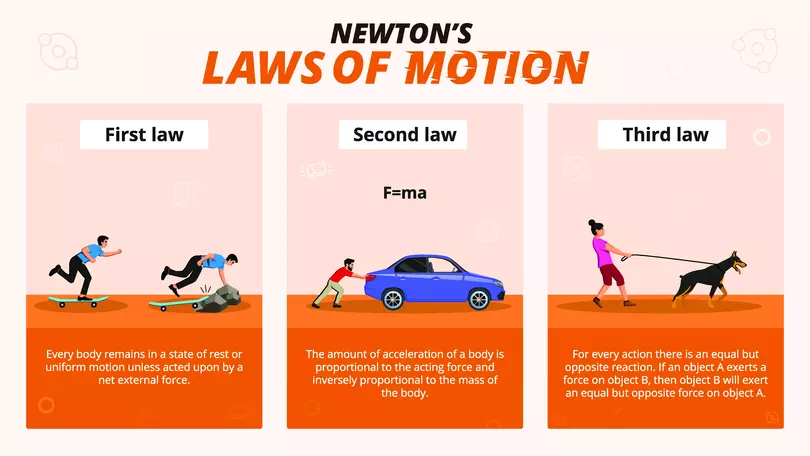How Newton's laws of motion impact real life: Exploring fun and engaging examples

Newton's laws of motion, formulated by Sir Isaac Newton in the 17th century, are fundamental principles that explain the motion of objects in the physical world. These laws have far-reaching applications and can be observed in various aspects of our daily lives.
In this article, we will explore how Newton's laws of motion relate to real life and provide fun examples to illustrate their concepts.
Watch our video lesson!
Note: This video lesson on Dynamics is just one of the many weekly GenieClass lessons you can attend from the comfort of your home. If you prefer learning in a physical classroom, check out our new tech-enhanced tuition classes at Geniebook CAMPUS.
Newton's Laws Of Motion: A Brief Overview
Before delving into specific examples, let's briefly understand Newton's three laws of motion.
- Newton's first law of motion: Law Of Inertia states that an object at rest will remain at rest, and an object in motion will continue moving in a straight line at a constant speed unless acted upon by an external force.
- Newton's second law of motion: Law Of Acceleration states that the acceleration of an object is directly proportional to the net force acting on it and inversely proportional to its mass.
- Newton's third law of motion: Law Of Action And Reaction states that for every action, there is an equal and opposite reaction.
Newton's 1st Law Of Motion: Law Of Inertia
Newton's first law, also known as the law of inertia, explains the behaviour of objects when no external force acts upon them. The law states that an object will maintain its state of motion unless acted upon by an external force.
Real-Life Applications Of Newton's 1st Law
🚗 Seatbelts And Car Accidents
When a car suddenly comes to a stop or experiences a collision, the passengers inside tend to keep moving forward due to inertia. Seatbelts are designed to apply a restraining force and prevent passengers from being thrown out of the vehicle.
⛸️ Slipping On Ice
Walking on a slippery surface, such as ice, can lead to loss of traction. If you suddenly stop on ice, your body's inertia will continue to carry you forward, causing you to slip and fall.
🚪 Opening And Closing Doors
When opening or closing a door, you may have noticed that you have to exert more force at the beginning to overcome the inertia of the door. Once the door is in motion, it requires less force to keep it moving or bring it to a stop.
Newton's 2nd Law Of Motion: Law Of Acceleration
Newton's second law states that the acceleration of an object is directly proportional to the net force acting on it and inversely proportional to its mass. Mathematically, this can be represented as
\(\large\text{F = m.a}\)
where \(\text{F}\) is the net force applied to the object, \(\text{m}\) is its mass, and \(\text{a}\) is the resulting acceleration.
Real-Life Applications Of Newton's 2nd Law
🎾 Throwing A Ball
When you throw a ball, the force exerted on it determines how fast it accelerates and how far it travels. Applying a greater force to the ball will result in a higher acceleration and a longer throw.
🚴🏼 Riding A Bicycle
While riding a bicycle, your pedalling force, combined with the mass of the bike and your body, determines the acceleration. Pushing harder on the pedals increases the net force, leading to faster acceleration.
🚘 Driving A Car
The acceleration of a car depends on the force exerted by the engine and the mass of the vehicle. A more powerful engine or a lighter car will result in quicker acceleration.
Newton's 3rd Law Of Motion: Law Of Action And Reaction
Newton's third law states that for every action, there is an equal and opposite reaction. When one object exerts a force on another object, the second object exerts an equal and opposite force back on the first object.
Real-Life Fun Examples Of Newton's 3rd Law
🎈 Balloon Rocket
Blowing up a balloon and releasing it causes the air to rush out in one direction, propelling the balloon in the opposite direction. The air escaping the balloon creates an action force, and the balloon moves in the opposite direction as the reaction force.
🤸🏽 Jumping On A Trampoline
When you jump on a trampoline, the trampoline surface pushes against your feet with an equal and opposite force, propelling you upward. The harder you push against the trampoline, the higher you'll bounce.
🏊🏻 Swimming And Pushing Water
While swimming, you push the water backwards with your arms and legs. According to Newton's third law, the water exerts an equal and opposite force, propelling you forward through the water.
So, we can say that Newton's laws of motion are not just abstract principles but have practical implications in our everyday lives. From seatbelts and car accidents to throwing a ball or jumping on a trampoline, these laws help us understand and predict the behaviour of objects in motion. By exploring real-life examples, we can appreciate the significance of Newton's laws and their applications in various scenarios.
In summary, we can use the diagram below to see how Newton's laws of motion apply in real life.

Frequently Asked Questions (FAQs)
How did Newton discover these laws of motion?
Sir Isaac Newton formulated his laws of motion based on observations and experiments he conducted in the 17th century. By studying the motion of objects and the forces acting upon them, he derived these fundamental principles.
Can you explain the law of inertia in simpler terms?
Certainly! The law of inertia, also known as Newton's first law of motion, states that objects at rest tend to stay at rest, and objects in motion tend to stay in motion unless acted upon by an external force. In simpler terms, an object will keep doing what it's already doing unless something makes it stop or change its motion.
What happens if the action and reaction forces are not equal and opposite?
According to Newton's third law of motion, every action has an equal and opposite reaction. If the action and reaction forces are not equal and opposite, there will be an imbalance of forces, resulting in a net force acting on the object. This net force causes the object to accelerate in the direction of the greater force, leading to motion or other observable effects.


 SG
SG  VN
VN 

















